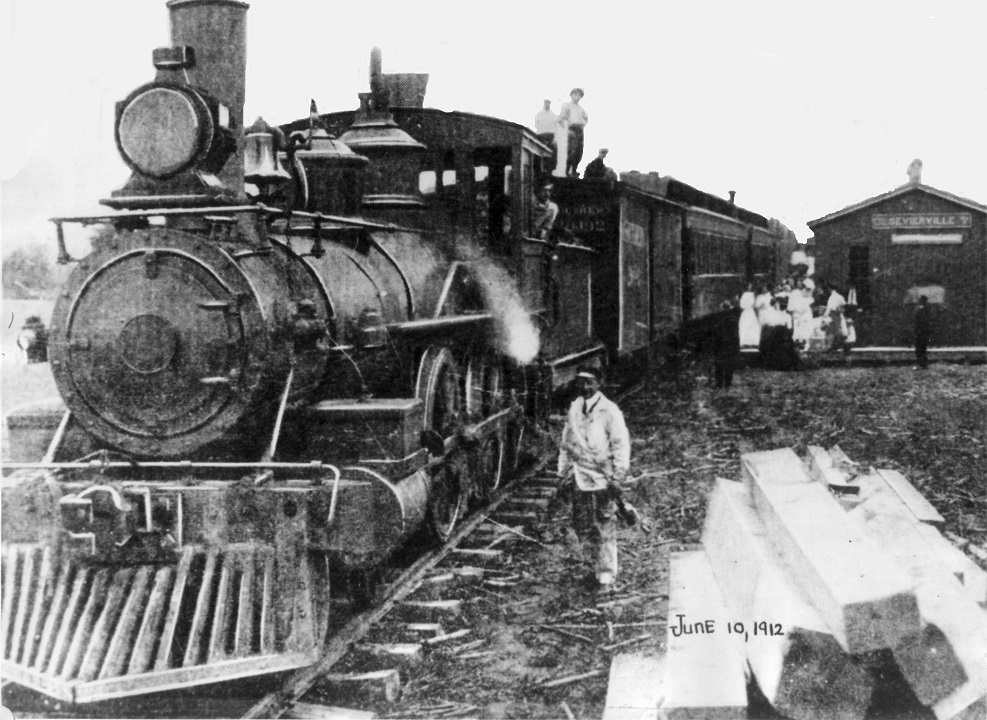| Home | History | Route | Locomotives | Rolling Stock | Operations | Gallery | Bibliography |

Not the first Knoxville, Sevierville & Eastern Railway train in Sevierville, but in June 1912, among the earliest. (Courtesy Sevier County Library)
The Smoky Mountain Railroad ran from Knoxville via Shook's Gap, Seymour and Boyd's Creek to Sevierville, a distance of some thirty miles; for a time it was extended about ten miles further to what is now Pigeon Forge. Construction actually began in June, 1908, under the leadership of William J. Oliver of Knoxville with the railroad reaching Sevierville in January, 1910. The Pigeon River was bridged in 1917 and the rails laid through the town. The final segment, intended to make use of the vast tracts of mountain timber, was never realized even though the rails did reach McCookville (near present day Pigeon Forge).
The history of the railroad may be divided into five periods during which the Smoky Mountain operated under different names. They were:
- The Knoxville, Sevierville & Eastern Railway Company (1907 - 1921),
- The Knoxville & Carolina Railroad Company (1921 - 1926),
- The Tennessee & North Carolina Railway (leased from the Smoky Mountain Railroad holding company and operated as the T&NC; Knoxville Division, 1927 - 1938),
- The Smoky Mountain Railroad Company (1927 - 1957), and
- The Smoky Mountain Railroad (operated by Sevier Countians 1957 - until abandonment was granted by the ICC in 1964).
Operating company timeline of the "Slow & Easy." (Knoxville, Slow & Easy graphic)Throughout its history the railroad suffered from various problems. The builder, William J. Oliver made money from its construction but had little interest in operating it. The second group of owners including L.C. Gunter and Colonel W.B. Townsend had grand plans but failed to carry them out with the road sold to a new group consisting of W.J. Parks, C. Boice and J.W. Bell under the charter name Smoky Mountain Railroad Company. Competition from trucks, cars and buses hurt the railroad and in 1937 the Smoky Mountain was sold to the Midwest Steel Corporation of West Virginia, operating under the Smoky Mountain charter. Midwest Steel was interested in scrap steel and tried its best to achieve bankruptcy in order to sell the steel from the road. When the Tennessee Valley Authority (TVA) decided to build Douglas Dam in 1941, it intervened to stop the abandonment process in order to make use of the Smoky Mountain to haul material to the dam site. For the only time in its history the railroad made money, but after completion of the dam, the owners again pushed for bankruptcy. Conditions finally became so bad that the railroad seemed doomed, when in 1957 a group of businessmen from Sevierville including A.J. King, J.E. Temple, J.B. Waters, Sr., James Atchley and several others, purchased the road.
The efforts of all of these men proved to be to no avail and the road begun over 50 years earlier saw the last run of the train on January 16, 1961. Today, nothing remains of the track or equipment of "Old Slowpoke and Easy" with the exception of steam engine #110 which is operating as an excursion engine in southwestern Michigan. (Actually, locomotive #107 and #206 survive as static displays, while diesel #440 remains serviceable. --Webmaster) Ironically, the Midwest Steel Corporation would in the end get the last assets of the Smoky Mountain - its rails - for $95,100 in 1964.
WEBMASTER'S NOTE: On May 15, 1969, Mr. William Robert Rogers, then-Principal of Seymour (Tennessee) High School and a native Sevier Countian, submitted his Master's thesis to the University Of Tennessee. This 112-page work, entitled A History Of The Smoky Mountain Railroad, was the culmination of Rogers' exhaustive research, at times greatly hindered by scattered company records and a lack of general information about the line. For three decades, his thesis has remained the "source document" for SMRR devotees. Numerous authors have paraphrased or quoted Rogers, and we are forever grateful for his pioneering role in preserving Ol' Smoky's history.
Text copyright © 1999 - 2018 Knoxville, Slow & Easy
| Home | History | Route | Locomotives | Rolling Stock | Operations | Gallery | Bibliography |